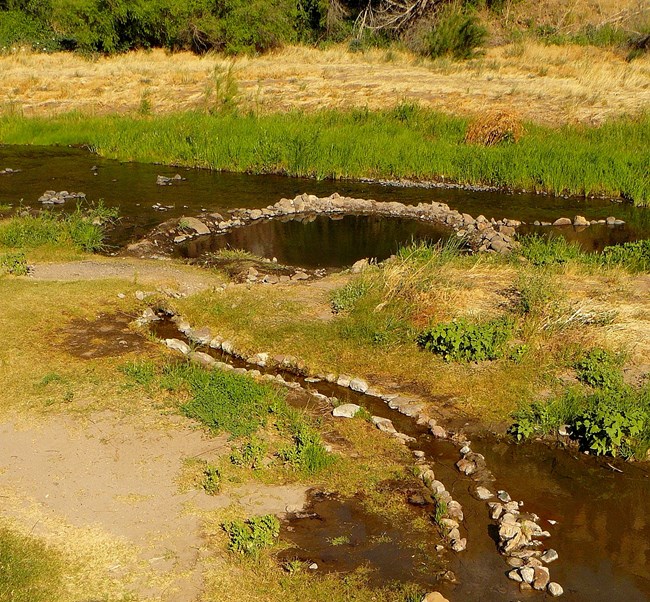
NPS Photo The Gila Cliff Dwellings National Monument is nestled in a region with a rich and complex geological history, shaped by millions of years of volcanic activity, erosion, and sedimentation. The dramatic landscape we see today, with its deep canyons and rugged terrain, is a testament to the powerful forces that have molded this area over time. Volcanic Origins and ErosionThe Gila region's geology is dominated by volcanic rocks, formed during a period of intense volcanic activity around 30 million years ago, during the late Tertiary period. This activity was part of the broader Mogollon-Datil volcanic field, which stretches across much of southwestern New Mexico. Over time, the eruptions deposited vast amounts of volcanic material, including ash, lava, and tuff, which have since been shaped by erosion into the landscape we see today. Gila ConglomerateOne of the key geological units in the area is the Gila Conglomerate, a sedimentary rock formed during the late Miocene to early Pleistocene epochs. This rock is composed of a mix of volcanic debris, gravel, and sand, cemented together over millions of years. The conglomerate contains clasts of various volcanic rocks, including basalt, andesite, and rhyolite, embedded in a finer-grained matrix. The presence of the Gila Conglomerate indicates ancient river systems that once flowed through the region, carrying and depositing eroded volcanic material from nearby highlands. BasaltBasalt is a common extrusive igneous rock in the Gila region, formed from the rapid cooling of low-viscosity lava that erupted onto the Earth’s surface. These eruptions, part of the late Tertiary volcanic activity, produced dark, fine-grained basalt, composed mainly of plagioclase, pyroxene, and olivine. Remnants of ancient basalt lava flows can still be seen capping mesas and forming other high-standing features in the landscape. AndesiteAnother key volcanic rock in the region is andesite, which forms from intermediate-composition lava. Andesite typically erupts from stratovolcanoes, which were likely prominent in the region during its volcanic past. Andesite is generally lighter in color than basalt, with shades ranging from light to dark gray, and is composed of plagioclase along with smaller amounts of amphibole, pyroxene, and biotite. In the Gila area, andesite forms layers representing ancient lava flows and volcanic domes, contributing to the region’s rugged topography. RhyoliteRhyolite, a high-silica extrusive igneous rock, is another important component of the Gila geology. It forms from the slow cooling of viscous lava, often associated with explosive volcanic eruptions. Rhyolite is typically light in color, ranging from pale pink to light gray, and contains quartz and feldspar, with minor amounts of biotite and hornblende. The rhyolite in the Gila region is found as part of volcanic domes, lava flows, and thick tuff deposits. Its resistance to weathering has helped shape the high-relief terrain of the area. 
NPS Photo Soak It InAll that volcanism has left several hot springs in the National Forest, some within hiking distance of the Gila Visitor Center. Two of the most popular are Jordan Hot Spring and Lightfeather Hot Spring. These springs are high in mineral content and have been sought out for generations for therapeutic benefits, even as far back as the Mogollon. They are known as sweet springs, however, because they lack salt and sulfur, as well as that distinct, pungent sulfur smell. LightfeatherLightfeather Hot Spring is about a 3/4 mile, twenty minute walk from the Gila Visitor Center along Trail 157, the Middle Fork Trail. It is situated in a steep canyon and flows from the base of a hill into the Middle Fork of the Gila River. The water pulses from the ground in about one minute increments and has a temperature of about 130 degrees. With such scalding temperatures, it's important to avoid the source and instead soak in the rock-lined pools constructed in the Middle Fork and maintained by visitors and local residents. Geothermal activity may cause the rocks in the riverbed to be hot in some spots. 
NPS Photo JordanJordan Hot Spring is about a seven mile hike via Little Bear Canyon, Trail 729, or a little over eight miles via the Middle Fork route. Each route features many river crossings. The hike is moderately strenuous and, while some do experience it as a day hike, it's recommended as an overnight. There are a number of camp sites both above and below the spring. Due to the popularity of this destination, firewood can be hard to come by. Please remember that it is unlawful to cut down trees or brush for fires; only dead and down wood should be used. Also, the spring is in the wilderness. Leave-no-trace practices should be followed.The hot spring's pool is about twenty feet in diameter, about three feet deep, and has a water temperature of about 94 degrees Fahrenheit. For this reason, some refer to Jordan as a "warm spring." Again, it's a very popular destination, especially during periods of increased visitation, such as spring break. Planning is advised when visiting during such times. You may want to consider other alternatives such as Melanie Hot Spring or the commercial pools found in the nearby village of Gila Hot Springs. A Note on Amoebic MeningitisWhen soaking in natural hot springs, it's important to note the possible existence of Naegleria fowleri, a free-living amoeba that inhabits soils and warm freshwater throughout the world. N. fowleri is also known as the "brain-eating amoeba" because it can cause primary amoebic meningoencephalitis (PAM) if introduced into the body through the nose. While the condition is rare, it's also deadly. This doesn't mean that natural hot springs are dangerous, but in order to avoid infection you shouldn't submerge your face in the water. |
Last updated: April 24, 2025
